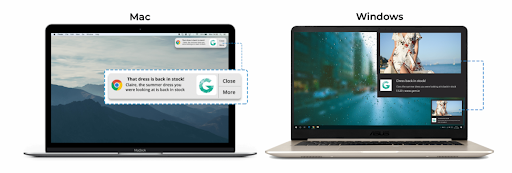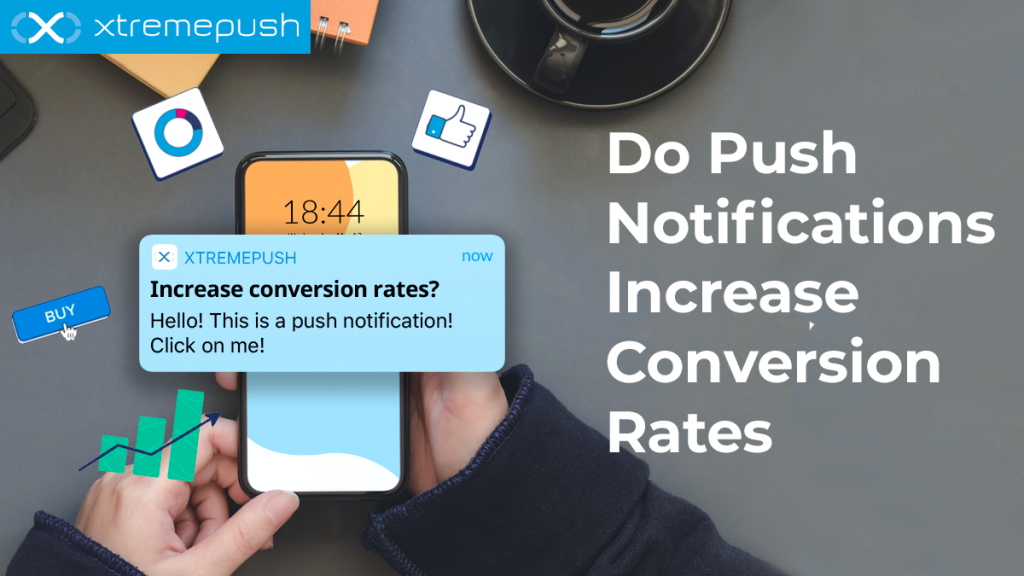The ability for push notifications to drive conversions hinges on more than its functionality. They’re used by so many businesses that no one really questions them, they’re just something that appears. It’s almost taken as a given that they work and that users find them helpful.
Providing your push notifications are relevant to your audience, your interaction rates should generally increase. You can boost performance by including visual media as this has shown to increase click through rates. But, when it comes to your bottom line, it’s the conversion rates you should be concentrating on.
The way in which you approach your notifications is incredibly important in driving their performance. A campaign thrown together with little thought will underperform. You get as much out as you put in.
When developing your push strategy you need to consider the following:
- Web push, app push or both. If you don’t have an app, this decision has been made for you.
- Determine what products will engage the customer to continue through the journey.
- Identify what rich media will resonate with your audience.
- Make sure your messaging will be relevant to your customers.
- Implement a reporting process so you can iterate and improve performance.
There will always be an element of trial and error with your early campaigns. Gather as much customer data together as you can to give yourself the best jumping off point. Then split test your campaigns to determine which messages work best for your audience.
App Push vs Web Push
Push notifications help you to communicate with your customers more immediately than email or SMS.
It’s less interruptive as they are already interacting with your site or app and therefore are more relevant too. Not least because if they’re actively browsing as any offer or promotion will hold greater importance to them.
However, there are important differences between app push notifications and web push notifications. The main one being the channel of delivery. Of course, app push is sent to your app users on their mobile device. Web push notifications are sent to those browsing the web.
But, there are a few key differences in terms of the user experience. These two channels of delivery offer something slightly different.
Deliverability
A benefit of app push notifications is that it can always be sent to a user. People often have their phone locked and in their pocket. But they can still receive notifications.
More importantly, their phone will buzz as they receive it, prompting them to check what’s going on.
When it comes to sending web push notifications, it gets a little trickier. Someone must be actively browsing the web in order to receive one. It’s not a total blocker, but means that your window for communication isn’t as wide.
Users also have to opt in to a web push notification so your messaging can be totally blocked by the user.
Updates
There are a few annoyances when it comes to apps. But very few are more annoying than needing to constantly update it.
Updates can be incredibly frustrating for users. It takes up time and space on their phone. Often, this leads to the app being deleted by the user and now you have one less channel of communication.
Web push will always be a useful and safe channel to go down. This is because there are very few updates you need to make to use it. It doesn’t cause as much frustration for users, so they will always be there.
Supporting Rich Media
A very useful and engaging aspect of using push notifications is that it often supports the use of rich media. Visual media leads to a higher interaction rate, and both channels generally support the use of rich media.
When it comes to sending your web push notifications they will appear different on a Mac as opposed to a Windows device. Marketers need to take this into account when creating a campaign.

The same applies when sending app push notifications. They will appear differently on an iOS device when compared to an Android device.
Why sending Push Notifications is a Good Idea
Communicating with your customers through any and every channel you can may seem like a good idea. And it can be, providing what you have to say adds value.
Customers are fickle and by bombarding customers with messages and emails you run the risk of them disengaging. Specifically unsubscribing, deleting apps and opting out of communications.
Thanks to the customer data at your disposal you have the ability to identify what channel your customers react to best and communicate through that.
But there’s something snappy and eye-catching about push notifications that people really respond to.
Push notifications are one of the most effective ways of communicating with your customers. Some businesses experience as much as an 85% increase in engagement through their use. And when engagement increases, so do CTR and conversion rates.
Real-time Event Triggers
This is possibly it’s biggest appeal. They are a chance to send messages to your users while they are using their device. Therefore, they are highly likely to see it straight away.
Compare that to an email, which could be sitting in an inbox for hours or days before the recipient sees it, if at all.
Campaigns for app and web push can be triggered by actions or behavioural patterns. This allows you to capitalise on engagement opportunities as they occur. You can deep link your notifications and lead users to a specific page on your app or website.
Dynamic Content
Every single message you send to a customer should be personalised and relevant to them. You won’t get much of a response if they’re not.
When you personalise a message the information is pulled from profiles stored in your marketing platform. Dynamic content refers to constantly updated information pulled in via an API.
There is near limitless information you can pull to inform the push notifications you send. Customers and businesses both see the benefit. Customers get more relevant offers that improve their shopping experience, and the business increases revenue, average spend and repeat business.
Cost Efficiency
Compared to the cost of other channels, push notifications are relatively inexpensive. This makes them an ideal channel for reaching huge volumes of users and generating ROI.
Impact on conversion rates
Conversions might mean different things to different businesses. Push notifications are an excellent way to achieve any of your business goals.
But when it comes to eCommerce, our conversions usually focus around customers making a purchase. Push notifications definitely have a positive impact on this.
In 2021, the average conversion rate for eCommerce push notifications was just below the 23% mark. That’s just for one push. That far exceeds the average unaided eCommerce conversion rate.
The frequency at which you send a push notification to your users has an effect on conversion rates. Some have seen their conversion rates grow fourfold by sending two notifications a week. A significant increase.
You can go a little further as well. Use data to segment your audiences before sending a push and you can expect an increase in open rates in excess of 50%. Of course, leading to an increase in conversions.
Better yet, the inclusion of rich media in your notifications will help to increase open rates too. Some businesses have experienced a 50% increase with the use of rich media.
Push Notification Best practices
Although push notifications are probably the best way to communicate with customers, that doesn’t mean they’ll always work.
It’s important that you approach them methodically with your customers best interests in mind. If you set them up on a whim they won’t deliver results.
Below are a few things you can keep in mind when approaching them. This will give you the best chance at delivering an increase in conversion rates.
Personalisation
No one wants to receive generic “Hello there” messages. They aren’t engaging for customers and they don’t deliver results for you as a business.
You should have customer data at your disposal to bring in dynamic content and make your notifications more personalised and engaging. If you don’t have that data, you should start to collect it.
Try to be as granular as possible when personalising push notifications. The smaller touches really do have an impact on engagement rates.
Basic personalisation leads to a 9% increase in open rates. So the more in depth your personalisation is, the higher that number becomes.
Segment your Users
Segmentation is an important aspect of communicating with your customers and ensuring the relevance of your message. And when it comes to communicating with customers, relevance is key.
When done right, campaigns targeted through customer segmentation increases your CTR by 50%. And , if done consistently, you can expect your retention rate to increase by 39%.
A/B Testing
You don’t want to run the risk of your push campaigns becoming stale. Something that worked for you in the past may not work for you again in the future.
This is why A/B testing is so important. It allows you to understand what does, and what doesn’t work for your customers. By understanding this, you can make changes to your campaigns to make them as optimised as possible.
Your push notifications are incredibly important for customer engagement and retention. By executing them well, you will start to see some great results, especially with your conversion rates.
To learn more about how you can use push notifications to engage your web and app users, get in touch and request a demo.
About Xtremepush
Xtremepush is the world’s leading customer data and engagement data platform. We work with various top brands within the eCommerce industry. Schedule a personalised demo of our platform to learn more about how we can help your brand drive repeat customers and increase revenue.
